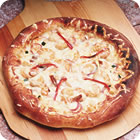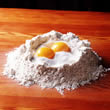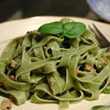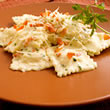SELECT THE RIGHT SPUD
Washington grows the perfect potato for almost every fresh or processed use. Potato characteristics are grouped by variety, by skin color, by shape and by use.Two important qualities of each variety determine the best way to prepare it. These are:
- Starch content
- Moisture content
High starch/low moisture potatoes are also described as having high solids. Washington russet varieties average 20-23 percent solids and are best for baking, mashing, frying or pureeing. The cooked potato is described as dry, fluffy and mealy. This is because the large starch granules absorb the internal moisture as they cook, then expand and burst, creating the mealy texture that results in fluffy baked potatoes, light mashed and pureed potatoes and crisp-outside-fluffy-inside French fries.High starch/low moisture Russet Burbanks are preferred for French frying because their low sugar content keeps them from discoloring as they fry and because starch on the surface of the cut potatoes expands with the heat and dries the surface as it absorbs water from the potato. The result is a crisp skin with a fluffy interior. Fries made from high moisture varieties (reds) go limp because the internal moisture content turns to steam as they cook. Early season Russet Norkotahs, though light-frying, have lower solids than Burbanks, so have to be watched for oil absorption during frying. Norkotahs increase in sugar content during storage, so those coming out of storage in the spring and summer may darken when fried.
Low to medium starch/high to medium moisture potatoes are frequently described as waxy and are preferred for boiling, steaming, braising, stewing, in salads, slices and those preparations where it’s important that the potato pieces hold their shape through the cooking process. Lower starch potatoes (reds, yellows) absorb less water when cooked. Their cells do not separate and swell but remain firm and waxy. These potatoes are described as smooth, creamy and moist.
New Potatoes are freshly harvested tiny potatoes of any variety. Their skin is tender, and they do not need to be peeled. Small round red potatoes are often mistakenly identified as new potatoes. New potatoes are best used soon after harvest, boiled, steamed or roasted.
| Variety | Cooking Method |
Russets
Whites, Yellows
Reds | Bake, mash, French fry
All-purpose
Boil |
|
PURCHASING POTATOES
Whatever the variety, look for potatoes that are firm, smooth and fairly clean. Avoid those with wrinkled or wilted skins, soft dark areas, discoloration, cut or bruised surfaces or greening.When purchasing potatoes consider:
- Storability
- Menu use
- Cooking method
- Plate presentation
- Flavor
- Color
Then specify by:
- Variety
- Size
- Grade
- Number of (50-pound) cartons
For example, for 140 baked potatoes, each to be served on a 10- to 12-inch plate with a 6- to 8-ounce portion of meat or fish, specify:
Washington Norkotahs, 70 count,
Grade No. 1, 2 (50-lb.) cartons
HANDLING
At receiving, check the shipment against specs for variety, size/count, number and condition of boxes.
- Avoid green tinged, sprouted or bruised potatoes.
- Handle with care - do not throw or drop boxes as potatoes can bruise easily.
- Move immediately into proper storage.
STORAGE
The right storage conditions will help potatoes maintain their quality.Store potatoes for all uses except French frying (see below) in a cool (42-45°F), dark, well-ventilated area, away from strong-smelling produce, preferably in closed or covered cartons and on pallets for air circulation.
Store away from other fruits and vegetables, especially onions as they may transfer odors and gases that affect quality.
- DO NOT refrigerate
- DO NOT freeze
- HANDLE carefully - potatoes can bruise
- DO NOT wash potatoes until ready to peel or prepare
Here’s why:
Temperatures warmer than 45°F encourage sprouting and shriveling; colder than 42°F encourage transformation of starch to sugar, which changes the taste and the cooking properties. There is one exception - see Storage for Potatoes to Be French Fried.
Keep them in the dark. Storage in direct light can produce greening (actually the production of chlorophyll) which gives a bitter flavor and, in very large quantities, can be harmful to eat. Trim or peel small green spots before preparation. Discard very green potatoes.
Storage for Potatoes To Be French Fried. For the very best French fries, Washington russet potatoes should be stored at 45°-50°F from harvest until ready to use. If stored at temperatures below 45° (in a refrigerator, for example) the starch turns to sugar and the fries will turn dark, caramelize and soak up the cooking oil, making them greasy when cooked. Potatoes out of storage in the late fall/early winter are best for fresh-cut French fries.
Preparation

- Wash well in warm running water and scrub with clean vegetable brush. Do not break the skin. Scrub new potatoes gently - their skin is tender. Potatoes can be arranged flat in dish racksand run through the dishwasher WITHOUT detergent.
- Trim off any sprouts and peel any green tinged portion.
- Unless recipe directs otherwise, cook with peels on.
- See Basic Cooking Methods (below).
DISCOLORATION
Uncooked cut or peeled potatoes will discolor due to exposure to the air. The potatoes may first turn pink, then brownish, then dark gray. None of the discoloration is harmful and usually disappears during cooking. To prevent discoloration, keep cut potatoes covered with cold water until ready to use - up to two hours. Holding longer than two hours will reduce some of the valuable water soluble nutrients.Cooked potatoes sometimes develop grey/blue/black areas as they cool. Just trim away the discolored portions.
Temperature changes during the growing season may cause some potatoes to develop harmless dark spots in the center. Just cut out and discard - the potatoes are safe to eat.
BASIC COOKING METHODS
When cooking Washington potatoes, remember to:
- Select the variety, grade and size best suited to the cooking method
- Select similar sized potatoes or cut potatoes into similar sizes and shapes for even cooking
- Keep pre-sliced or pre-cut potatoes covered in cold water to prevent discoloration
- When cooking in water, start potatoes in cold water so they will cook evenly
BAKE
(Russets, Grade No. 1)

Foil or not? Not! Experts agree that wrapping potatoes in foil for baking actually increases the cooking time and, because the steam is trapped, makes the skin and flesh soggy.
- Scrub well. Rub each potato lightly with cooking oil.
- Pierce each potato several times with a fork so steam can escape.
- Arrange in an even layer on a baking sheet for easier handling.
- Conventional Oven - Bake at 425°F for 50 to 55 minutes for 90 count.
- Convection Oven - Bake at 375°F for 50 to 55 minutes.
Larger potatoes will take longer to cook. Those cooked on a baking sheet may need turning for even cooking. Potatoes are done if tender when pierced with a fork and the internal temperature

reaches 210°F. Keep in a warming drawer or under a heat lamp for no more than 20 minutes before serving. Wrapping potatoes in foil after cooking does help hold temperature, but will also soften skin.
To serve, cut cross in top, then squeeze ends and push to center. Fluff center with a fork.
STEAM

(Reds, Whites, Yellows, Blues, Grade No. 1 if served whole and unpeeled, may use Grade No. 2 if peeled, sliced or cut)
Scrub well. Place on rack over 1/2 inch boiling water or in steamer tray. Cover tightly or close steamer. Steam until tender.

- Pressure Steamer - 25 to 30 minutes for 6 pounds.
- Convection Steamer - 40 to 45 minutes for 6 pounds.
Potatoes to be steamed can be peeled before or after cooking.
BOIL

(All Varieties, Grade No. 1 if served whole and unpeeled, may use Grade No. 2 if peeled, sliced or cut)
Scrub well. Cut into quarters or even-sized pieces. Put in pot and add cold water to completely cover potatoes. Add salt. Heat to boiling, then reduce heat and simmer until tender when pierced with a fork, 20 to 30 minutes, depending on size. Drain thoroughly.

To dry potatoes before mashing or other preparations, return to pot and place, uncovered, over very low heat OR return to pot and place paper towel or cloth towel between pot and lid OR arrange in single layer on sheet pan and hold in warm oven. Remove skin as soon as potatoes are cool enough to handle.
Note: for preparations using distinct pieces, drain in small portions. Dumping a large amount into a colander to drain will crush pieces at bottom of colander - not a problem for mashed or pureed potatoes, but not good for salad pieces.
FRENCH FRYING
(Russets, Grade No. 2)
See Storage and be sure potatoes have been stored between 45°-50°F.

Scrub potatoes well. Peel or not? Some menus now feature fries with peel on. Cut into desired shape - usually 3/8-inch thick. For crisp finished fries, chill peeled, cut potatoes in cold water to cover, with lemon juice or vinegar (1 ounce per gallon water) added to water to prevent darkening, for 1/2 to 2 hours before frying. Rinse, then drain well or spin dry and dry on paper towels. (Any moisture on potatoes will cause oil to spatter and can be dangerous.)

Heat high quality vegetable oil in 5-gallon fryer to 375°F. Add 2 pounds prepared potatoes to fryer basket, put into hot oil and cook until golden brown and cooked through, about 4 to 5 minutes.
Lift basket out of oil and drain. Turn into paper towel-lined pan. Season with salt.
For Blanched or Double Fried Potatoes, prepare as above. Blanch by frying at 350°F until tender but not brown, about 2 to 3 minutes. Drain well and turn out onto paper towels. Let cool to room temperature or refrigerate, uncovered, until ready to fry for service. At service time, deep fry at 375°F until golden brown and crisp, about 2 minutes. Drain well. Season with salt.
Do not hold under warming lights or in warming cabinet more than 5 minutes.
Note: Do not salt potatoes before frying or while in fryer. Salt causes the oil to break down.
ROAST

(Russets, Reds, Yellows, Whites, Blues, Grade No. 1 or 2 depending on if peeled and cut)
Scrub potatoes well. Peel or not, depending on desired usage and appearance. Dry peeled potatoes. Leave whole or cut into even-sized pieces. Brush or toss with vegetable oil or other fat (roast drippings, clarified butter, poultry fat) and salt. Sprinkle with herbs, if desired.

Pierce whole potatoes. Arrange in single layer in roasting pan, leaving a little space between each potato for even browning. Roast at 425°F in conventional oven, stirring several times for even browning, until tender, about 1 hour for 6-ounce potatoes.
MASH

(Russets, Whites, Yellows, Grade No. 2)
Scrub potatoes well. Pare or not. Cut into quarters or even sized chunks and cook as follows: (times are based on 6 pounds of potatoes)
- Steam jacketed kettle in boiling salted water to cover until tender, about 20 to 30 minutes, depending on size. Start in cold water for even cooking.
- Pressure steamer - 25 to 30 minutes.
- Convection steamer - 40 to 45 minutes.
- Range top in boiling salted water to cover, until tender, about 60 minutes. Start in cold water for even cooking.
Drain well, keep hot. Turn into mixer bowl and add hot milk, butter, salt and pepper. Whip 1 minute at low speed and 1 minute at high speed. Never over beat as that will breakdown the starch, and potatoes will become shiny and sticky.

For fluffier mashed potatoes, press potatoes through food grinder, food mill or ricer before mixing, or hand mash, then mix with hot milk, butter salt and pepper. Hold mashed potatoes, covered, on preheated steam table or warmer or in water bath for no more than 60 minutes.
To prepare mashed potatoes from leftover baked/cooked potatoes, steam until heated through, then mash as above.
SAUTÉ: HOME FRIES, PANCAKES, HASH BROWNS, ANNA

(Whites, Yellows, Reds, Grade No. 2)
Scrub potatoes well. Pare or not. Hold in cold water if prepared in advance, then drain well and pat dry. Par-cook by boiling or steaming, if desired. Cut into 1/4- to 1/2-inch slices, shreds or 3/4-inch cubes. Use skillet large enough to hold potatoes without crowding.

Add enough oil to skillet to cover bottom and heat until oil is hot. Arrange potatoes in single layer in skillet. Cover and cook over medium heat until browned and tender, about 10 minutes if not pre-cooked. Stir or shake pan to brown potatoes evenly.Cook hash browns on 375°F grill. Do not hold more than 5 to 10 minutes before serving.
MICROWAVE BAKE

(Russets, Grade No. 1)
Scrub potatoes and pierce as for baked potatoes. Wrap each potato in microwave safe paper towel. Place end to end in single layer in circle in oven with about 1 inch between each potato. Cooking time will vary with size of potato and wattage of oven. Microwave on High.

Turn potatoes over and change position in the oven halfway through the cooking time. Let stand, still in paper towels, 5 minutes to complete cooking. Times below are for 8-ounce potatoes in 1000 watt oven
- 1 potato — 5 minutes.
- potatoes — 7 - 8 minutes.
- potatoes — 13 - 15 minutes.
SCALLOPED/AU GRATIN

(Reds, Yellows, Whites, Grade No.2)
Scrub, peel and slice potatoes 1/8- to 1/16-inch thick and layer in buttered or oiled hotel pans. Par-cook potatoes in liquid to be used for sauce, if desired, to shorten total baking time. Drain par-cooked potatoes, reserving liquid to prepare white or cheese sauce. Pour hot white or cheese sauce over potatoes in pans, shaking pans gently to distribute liquid. Scatter buttered bread crumbs over top for au gratin potatoes.

Bake at 325°F in conventional oven until potatoes are tender and top is golden brown, about 1 hour. If potatoes are done before top browns, run under salamander or broiler to brown top. Let stand about 10 minutes before cutting squares to serve.












 Foil or not? Not! Experts agree that wrapping potatoes in foil for baking actually increases the cooking time and, because the steam is trapped, makes the skin and flesh soggy.
Foil or not? Not! Experts agree that wrapping potatoes in foil for baking actually increases the cooking time and, because the steam is trapped, makes the skin and flesh soggy. reaches 210°F. Keep in a warming drawer or under a heat lamp for no more than 20 minutes before serving. Wrapping potatoes in foil after cooking does help hold temperature, but will also soften skin.
reaches 210°F. Keep in a warming drawer or under a heat lamp for no more than 20 minutes before serving. Wrapping potatoes in foil after cooking does help hold temperature, but will also soften skin. (Reds, Whites, Yellows, Blues, Grade No. 1 if served whole and unpeeled, may use Grade No. 2 if peeled, sliced or cut)
(Reds, Whites, Yellows, Blues, Grade No. 1 if served whole and unpeeled, may use Grade No. 2 if peeled, sliced or cut)
 (All Varieties, Grade No. 1 if served whole and unpeeled, may use Grade No. 2 if peeled, sliced or cut)
(All Varieties, Grade No. 1 if served whole and unpeeled, may use Grade No. 2 if peeled, sliced or cut) To dry potatoes before mashing or other preparations, return to pot and place, uncovered, over very low heat OR return to pot and place paper towel or cloth towel between pot and lid OR arrange in single layer on sheet pan and hold in warm oven. Remove skin as soon as potatoes are cool enough to handle.
To dry potatoes before mashing or other preparations, return to pot and place, uncovered, over very low heat OR return to pot and place paper towel or cloth towel between pot and lid OR arrange in single layer on sheet pan and hold in warm oven. Remove skin as soon as potatoes are cool enough to handle. Scrub potatoes well. Peel or not? Some menus now feature fries with peel on. Cut into desired shape - usually 3/8-inch thick. For crisp finished fries, chill peeled, cut potatoes in cold water to cover, with lemon juice or vinegar (1 ounce per gallon water) added to water to prevent darkening, for 1/2 to 2 hours before frying. Rinse, then drain well or spin dry and dry on paper towels. (Any moisture on potatoes will cause oil to spatter and can be dangerous.)
Scrub potatoes well. Peel or not? Some menus now feature fries with peel on. Cut into desired shape - usually 3/8-inch thick. For crisp finished fries, chill peeled, cut potatoes in cold water to cover, with lemon juice or vinegar (1 ounce per gallon water) added to water to prevent darkening, for 1/2 to 2 hours before frying. Rinse, then drain well or spin dry and dry on paper towels. (Any moisture on potatoes will cause oil to spatter and can be dangerous.) Heat high quality vegetable oil in 5-gallon fryer to 375°F. Add 2 pounds prepared potatoes to fryer basket, put into hot oil and cook until golden brown and cooked through, about 4 to 5 minutes.
Heat high quality vegetable oil in 5-gallon fryer to 375°F. Add 2 pounds prepared potatoes to fryer basket, put into hot oil and cook until golden brown and cooked through, about 4 to 5 minutes. (Russets, Reds, Yellows, Whites, Blues, Grade No. 1 or 2 depending on if peeled and cut)
(Russets, Reds, Yellows, Whites, Blues, Grade No. 1 or 2 depending on if peeled and cut) Pierce whole potatoes. Arrange in single layer in roasting pan, leaving a little space between each potato for even browning. Roast at 425°F in conventional oven, stirring several times for even browning, until tender, about 1 hour for 6-ounce potatoes.
Pierce whole potatoes. Arrange in single layer in roasting pan, leaving a little space between each potato for even browning. Roast at 425°F in conventional oven, stirring several times for even browning, until tender, about 1 hour for 6-ounce potatoes. (Russets, Whites, Yellows, Grade No. 2)
(Russets, Whites, Yellows, Grade No. 2) For fluffier mashed potatoes, press potatoes through food grinder, food mill or ricer before mixing, or hand mash, then mix with hot milk, butter salt and pepper. Hold mashed potatoes, covered, on preheated steam table or warmer or in water bath for no more than 60 minutes.
For fluffier mashed potatoes, press potatoes through food grinder, food mill or ricer before mixing, or hand mash, then mix with hot milk, butter salt and pepper. Hold mashed potatoes, covered, on preheated steam table or warmer or in water bath for no more than 60 minutes. (Whites, Yellows, Reds, Grade No. 2)
(Whites, Yellows, Reds, Grade No. 2) Add enough oil to skillet to cover bottom and heat until oil is hot. Arrange potatoes in single layer in skillet. Cover and cook over medium heat until browned and tender, about 10 minutes if not pre-cooked. Stir or shake pan to brown potatoes evenly.Cook hash browns on 375°F grill. Do not hold more than 5 to 10 minutes before serving.
Add enough oil to skillet to cover bottom and heat until oil is hot. Arrange potatoes in single layer in skillet. Cover and cook over medium heat until browned and tender, about 10 minutes if not pre-cooked. Stir or shake pan to brown potatoes evenly.Cook hash browns on 375°F grill. Do not hold more than 5 to 10 minutes before serving. (Russets, Grade No. 1)
(Russets, Grade No. 1) Turn potatoes over and change position in the oven halfway through the cooking time. Let stand, still in paper towels, 5 minutes to complete cooking. Times below are for 8-ounce potatoes in 1000 watt oven
Turn potatoes over and change position in the oven halfway through the cooking time. Let stand, still in paper towels, 5 minutes to complete cooking. Times below are for 8-ounce potatoes in 1000 watt oven (Reds, Yellows, Whites, Grade No.2)
(Reds, Yellows, Whites, Grade No.2) Bake at 325°F in conventional oven until potatoes are tender and top is golden brown, about 1 hour. If potatoes are done before top browns, run under salamander or broiler to brown top. Let stand about 10 minutes before cutting squares to serve.
Bake at 325°F in conventional oven until potatoes are tender and top is golden brown, about 1 hour. If potatoes are done before top browns, run under salamander or broiler to brown top. Let stand about 10 minutes before cutting squares to serve.